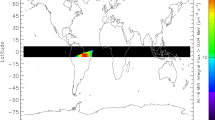Abstract
Minimization of the charged particle background in the x-ray detecting system is an important issue. Generally, there are four possible sources of damaging radiation for x-ray detecting systems, namely: geomagnetically trapped electrons, galactic cosmic ray particles, solar flare events, and onboard radiation sources that always cause noise and damage to the performance of the payload of a spacecraft. In order to alleviate the background noise of the x-ray detecting system, a magnetic diverter is proposed to shield the electrons. The main idea of this method is, using the Monte Carlo method, to follow the tracks of all the electrons and determine whether the electrons collide with the x-ray tube, how they collide, and other parameters of this collision. The number of deflected electrons can be obtained by computing all the physical parameters of electrons. As a result, the shielding efficiency of background noise can be calculated.
Firstly, the electron motion can be classified into the following three types: (1) electrons hit the detector directly, (2) electrons hit the rest of the area of the detector plane except for the active area of the detector, and (3) electrons hit the inner wall of the x-ray detecting system tube. In addition, in accordance with the relativity principle, the velocity of different electrons with different energies can be obtained. In order to mimic the actual motion of electrons, the incidence direction, incidence position and energy of electrons are assumed random.
Secondly, the whole simulation process is divided into two steps. One step is to simulate the motion of electrons in the x-ray detection system without a magnetic diverter, obtaining the number of electrons that arrive to the detector plane, except for the active detector area, and to the inner tube, respectively. The other step is to simulate the motion of electrons in the x-ray detecting system with a magnetic diverter and the initial magnetic parameters, calculating the number of electrons which arrive to the active area of the detector, to the detector plane except for the active area of the detector, and to the inner tube, respectively. As a result, the total shielding efficiency can be obtained.
Finally, in order to reduce the weight of the x-ray detecting system, the structure of the magnetic diverter has been designed and optimized based on the simulation results.
Access this chapter
Tax calculation will be finalised at checkout
Purchases are for personal use only
Similar content being viewed by others
References
Lo DH, Srour JR (2003) Modeling of proton-induced CCD degradation in the Chandra X-ray observatory. IEEE Trans Nucl Sci 50:2018–2023
Kołodziejczak JJ, Elsner RF, Austin RA, O’Dell SL (2000) Ion transmission to the focal plane of the Chandra X-ray observatory. SPIE Proc 4140:135–143
Carter JA, Read AM (2007) The XMM-Newton EPIC background and the production of background blank sky event files. Astron Astrophys 464:1155–1166
Willingale R (2000) An electron diverter for the Swift Telescope. XRA study note RT-LUX-RE-011/1, University of Leicester
Abele MG (1993) Structures of permanent magnets. Wiley, New York
Wattes JW Jr, Wright JJ (1976) Charged particle radiation environment for the Spacelab and other missions in low Earth orbit, revision A. NASA Technical Memorandum, TMX-73358, 29 Nov
Spiga D et al (2008) A magnetic diverter for charged particle background rejection in the SIMBOL-X telescope. In: Proceedings of SPIE. Space Telescopes and Instrumentation: Ultraviolet to Gamma Ray, vol 7011, p 70112Y. doi:10.1117/12.789917
Winkler CE, Dailey CC, Cumings NP (1991) Advanced X-ray astrophysics facility science instruments. In: Proceedings of SPIE, Space Astronomical Telescopes and Instruments, pp 301–311
Author information
Authors and Affiliations
Corresponding author
Editor information
Editors and Affiliations
Rights and permissions
Copyright information
© 2017 Springer International Publishing AG
About this paper
Cite this paper
Li, L., Wang, C., Deng, L., Zuo, F., Mei, Z., Lv, Z. (2017). Design and Simulation of a Magnetic Diverter Structure for the X-Ray Detecting System. In: Kleiman, J. (eds) Protection of Materials and Structures from the Space Environment. Astrophysics and Space Science Proceedings, vol 47. Springer, Cham. https://doi.org/10.1007/978-3-319-19309-0_54
Download citation
DOI: https://doi.org/10.1007/978-3-319-19309-0_54
Published:
Publisher Name: Springer, Cham
Print ISBN: 978-3-319-19308-3
Online ISBN: 978-3-319-19309-0
eBook Packages: Physics and AstronomyPhysics and Astronomy (R0)




